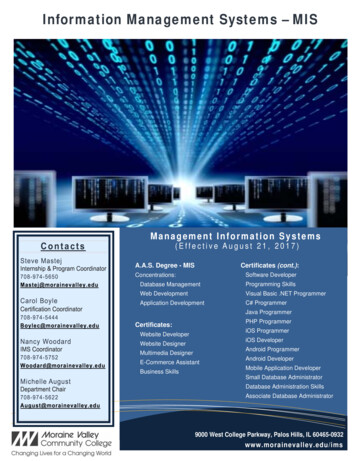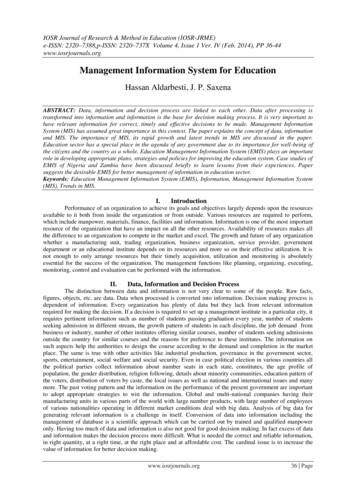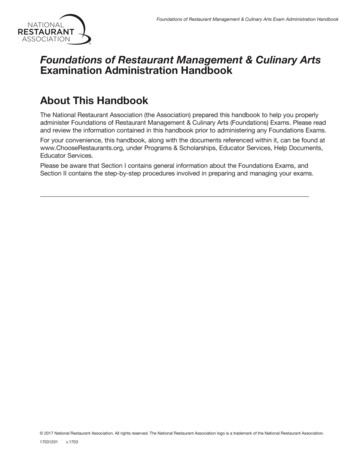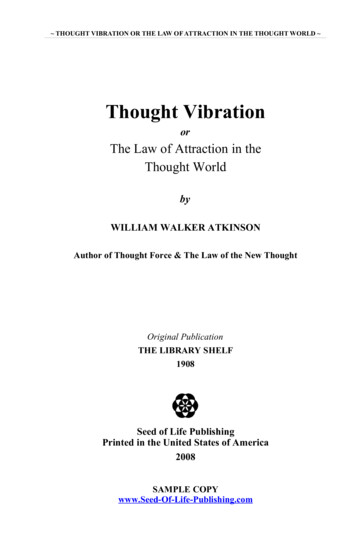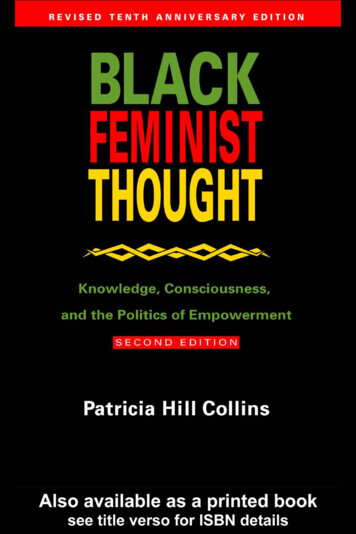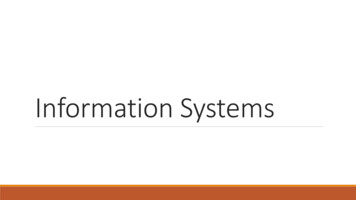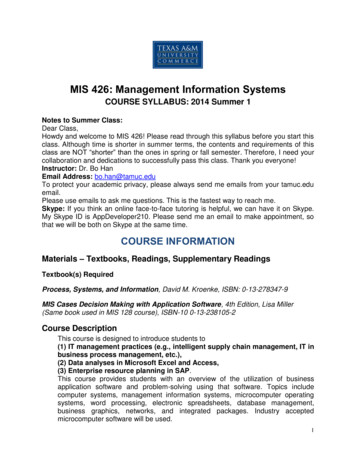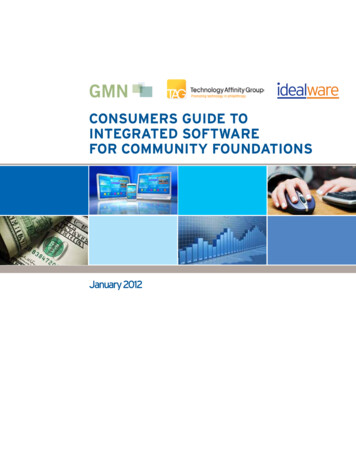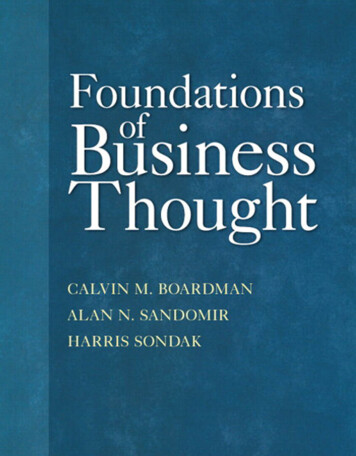
Transcription
Foundations of BusinessThought
This page intentionally left blank
Foundations of BusinessThoughtFirst EditionWith contributions byCalvin M. BoardmanProfessor of FinanceBill Daniels Chair in Business EthicsDavid Eccles School of BusinessUniversity of UtahAlan N. SandomirAssociate Professor (Lecturer) of MarketingDavid Eccles School of BusinessUniversity of UtahHarris SondakProfessor of ManagementDavid Eccles Faculty ScholarDavid Eccles School of BusinessUniversity of UtahBoston Columbus Indianapolis New York San Francisco Upper Saddle RiverAmsterdam Cape Town Dubai London Madrid Milan Munich Paris Montreal TorontoDelhi Mexico City São Paulo Sydney Hong Kong Seoul Singapore Taipei Tokyo
Editor In Chief: Stephanie WallAcquisitions Editor: James HeineDirector of Editorial Services: Ashley SantoraEditorial Project Manager: Karin WilliamsEditorial Assistant: Ashlee BradburyPermissions Manager: Melissa PelleranoDirector of Marketing: Patrice Lumumba JonesSenior Marketing Manager: Nikki Ayana JonesAssistant Marketing Manager: Ian GoldProduction Project Manager: Clara BartunekCreative Art Director: Jayne ConteCover Designer: Suzanne BehnkeFull-Service Project Management: Niraj Bhatt, Aptara , Inc.Printer/Binder: Edwards BrothersCover Printer: Lehigh / Phoenix HagerstownText Font: 10.5/13.5 PalatinoCredits and acknowledgments borrowed from other sources and reproduced, with permission, in thistextbook appear on the appropriate page within text or on page 533.Copyright 2013 by Pearson Education, Inc., publishing as Prentice Hall. All rights reserved.Manufactured in the United States of America. This publication is protected by Copyright, and permissionshould be obtained from the publisher prior to any prohibited reproduction, storage in a retrieval system, ortransmission in any form or by any means, electronic, mechanical, photocopying, recording, or likewise. Toobtain permission(s) to use material from this work, please submit a written request to Pearson Education,Inc., Permissions Department, One Lake Street, Upper Saddle River, New Jersey 07458, or you may faxyour request to 201-236-3290.Many of the designations by manufacturers and sellers to distinguish their products are claimed astrademarks. Where those designations appear in this book, and the publisher was aware of a trademarkclaim, the designations have been printed in initial caps or all caps.Library of Congress Cataloging-in-Publication DataBoardman, Calvin M.Foundations of business thought / Calvin M. Boardman, Alan N. Sandomir, Harris Sondak.p. cm.Includes index.ISBN-13: 978-0-13-285607-2ISBN-10: 0-13-285607-71. Business. I. Sandomir, Alan N. II. Sondak, Harris. III. Title.HF1008.B63 2013658--dc23201201603910 9 8 7 6 5 4 3 2 1ISBN 10:0-13-285607-7ISBN 13: 978-0-13-285607-2
ContentsFOREWORD . . . . . . . . . . . . . . . . . . . . . . . . . . . . . . . . . . . . . . . . . . 1I—INTRODUCTION . . . . . . . . . . . . . . . . . . . . . . . . . . . . . . . . . . . . . . 3A Written Word Is the Choicest of Relics . . . . . . . . . . . . . . . . . . . . . . . . . . . . . . . . . . . . . . . . 3Of Studies from The Essays . . . . . . . . . . . . . . . . . . . . . . . . . . . . . . . . . . . . . . . . . . . . . . . . . . . . 6Francis BaconReading from Walden . . . . . . . . . . . . . . . . . . . . . . . . . . . . . . . . . . . . . . . . . . . . . . . . . . . . . . . . . 7Henry David ThoreauFrom The Souls of Black Folk . . . . . . . . . . . . . . . . . . . . . . . . . . . . . . . . . . . . . . . . . . . . . . . . . . . 12W. E. B. DuBoisHow to Do Business from Safe Methods in Business . . . . . . . . . . . . . . . . . . . . . . . . . . . . . . . 14J. L. NicholsPractical Rules for Success from Safe Methods in Business . . . . . . . . . . . . . . . . . . . . . . . . . 15J. L. NicholsII—MOTIVATIONFOR THEDEVELOPMENTOFCOMMERCE. . . . . . . . . . . . . . 17Introduction: All That Is Solid Melts into Air . . . . . . . . . . . . . . . . . . . . . . . . . . . . . . . . . . . 17From The Journal of Christopher Columbus . . . . . . . . . . . . . . . . . . . . . . . . . . . . . . . . . . . . . . . 22Christopher Columbus, Clements Robert Markham,and Paolo del Pozzo TonscanelliA History of the Ancient World . . . . . . . . . . . . . . . . . . . . . . . . . . . . . . . . . . . . . . . . . . . . . . . . . 31Fray Bernardino De SahagunFrom The True History of the Conquest of New Spain . . . . . . . . . . . . . . . . . . . . . . . . . . . . . . . 34Bernal Díaz Del CastilloOf Property from The Second Treatise of Civil Government . . . . . . . . . . . . . . . . . . . . . . . . . . 42John Locke1879 Speech to Congress . . . . . . . . . . . . . . . . . . . . . . . . . . . . . . . . . . . . . . . . . . . . . . . . . . . . . . 51In-mut-too-yah-lat-lat, also known as Chief JosephFrom Faust Part Two . . . . . . . . . . . . . . . . . . . . . . . . . . . . . . . . . . . . . . . . . . . . . . . . . . . . . . . . . 63Johann Wolfgang von GoetheEconomy from Walden . . . . . . . . . . . . . . . . . . . . . . . . . . . . . . . . . . . . . . . . . . . . . . . . . . . . . . . 83Henry David ThoreauThe World Is Too Much With Us . . . . . . . . . . . . . . . . . . . . . . . . . . . . . . . . . . . . . . . . . . . . . . . 99William WordsworthIII—FOUNDATIONSOF ACOMMERCIAL SOCIETY . . . . . . . . . . . . . . . . . . 101Introduction: Don’t Know Much About History . . . . . . . . . . . . . . . . . . . . . . . . . . . . . . . . 101From The Republic . . . . . . . . . . . . . . . . . . . . . . . . . . . . . . . . . . . . . . . . . . . . . . . . . . . . . . . . . . 110Platov
viContentsFrom The Politics . . . . . . . . . . . . . . . . . . . . . . . . . . . . . . . . . . . . . . . . . . . . . . . . . . . . . . . . . . . 115AristotleLaissez-Faire Policy from The Economic Principlesof Confucius and His School . . . . . . . . . . . . . . . . . . . . . . . . . . . . . . . . . . . . . . . . . . . . . . . . . 120Chen Huan-ChangFrom An Inquiry into the Nature and Causesof the Wealth of Nations . . . . . . . . . . . . . . . . . . . . . . . . . . . . . . . . . . . . . . . . . . . . . . . . . . . . 124Adam SmithI, Pencil . . . . . . . . . . . . . . . . . . . . . . . . . . . . . . . . . . . . . . . . . . . . . . . . . . . . . . . . . . . . . . . . . . 129Leonard E. ReadFrom The Fable of the Bees . . . . . . . . . . . . . . . . . . . . . . . . . . . . . . . . . . . . . . . . . . . . . . . . . . . . 133Bernard MandevilleWealth from Essays and Journals . . . . . . . . . . . . . . . . . . . . . . . . . . . . . . . . . . . . . . . . . . . . . . 141Ralph Waldo EmersonThe Veins of Wealth from Unto This Last and Other Essayson Art and Political Economy . . . . . . . . . . . . . . . . . . . . . . . . . . . . . . . . . . . . . . . . . . . . . . . 155John RuskinFrom Acres of Diamonds . . . . . . . . . . . . . . . . . . . . . . . . . . . . . . . . . . . . . . . . . . . . . . . . . . . . . 163Russell H. ConwellFrom Atlas Shrugged . . . . . . . . . . . . . . . . . . . . . . . . . . . . . . . . . . . . . . . . . . . . . . . . . . . . . . . . 167Ayn RandTeaching Business to Ladies fromSafe Methods in Business . . . . . . . . . . . . . . . . . . . . . . . . . . . . . . . . . . . . . . . . . . . . . . . . . . . 172J. L. NicholsCapitalist Production from Das Kapital . . . . . . . . . . . . . . . . . . . . . . . . . . . . . . . . . . . . . . . . 174Karl MarxThe Social Organism from Religionand the Rise of Capitalism . . . . . . . . . . . . . . . . . . . . . . . . . . . . . . . . . . . . . . . . . . . . . . . . . . 178R. H. TawneyFrom The Protestant Ethic and the Spirit of Capitalism . . . . . . . . . . . . . . . . . . . . . . . . . . . . . 189Max WeberFrom The Acquisitive Society . . . . . . . . . . . . . . . . . . . . . . . . . . . . . . . . . . . . . . . . . . . . . . . . . 198R. H. TawneyFrom The Gospel of Wealth . . . . . . . . . . . . . . . . . . . . . . . . . . . . . . . . . . . . . . . . . . . . . . . . . . . 204Andrew CarnegieTeaching Business to Children from Safe Methods in Business . . . . . . . . . . . . . . . . . . . . . 212J. L. NicholsFrom The Personal Relation in Industry . . . . . . . . . . . . . . . . . . . . . . . . . . . . . . . . . . . . . . . . . 214John D. Rockefeller, Jr.The Social Responsibility of Business Is to Increase Its Profits . . . . . . . . . . . . . . . . . . . . . . . . 221Milton FriedmanThe Shuchu Kiyaku . . . . . . . . . . . . . . . . . . . . . . . . . . . . . . . . . . . . . . . . . . . . . . . . . . . . . . . . . 227Seika Fujiwara
ContentsviiIV—MARKETING . . . . . . . . . . . . . . . . . . . . . . . . . . . . . . . . . . . . . 229Introduction: You Are Who You Think You Are;So Be Careful About Who You Think You Are . . . . . . . . . . . . . . . . . . . . . . . . . . . . . . . 229From The Art of War . . . . . . . . . . . . . . . . . . . . . . . . . . . . . . . . . . . . . . . . . . . . . . . . . . . . . . . . 234Sun TzuFrom De Officiis . . . . . . . . . . . . . . . . . . . . . . . . . . . . . . . . . . . . . . . . . . . . . . . . . . . . . . . . . . . . 245CiceroOf Cheating, Which Is Committed in Buying and Sellingfrom The Summa Theologica . . . . . . . . . . . . . . . . . . . . . . . . . . . . . . . . . . . . . . . . . . . . . . . . 251Thomas AquinasHonesty from Safe Methods in Business . . . . . . . . . . . . . . . . . . . . . . . . . . . . . . . . . . . . . . . . 259J. L. NicholsRapid Methods for Marking Goods from Safe Methods in Business. . . . . . . . . . . . . . . . . 261J. L. NicholsNatural Selection from The Origin of Species . . . . . . . . . . . . . . . . . . . . . . . . . . . . . . . . . . . . 262Charles DarwinFrom The Financier . . . . . . . . . . . . . . . . . . . . . . . . . . . . . . . . . . . . . . . . . . . . . . . . . . . . . . . . . 266Theodore DreiserPecuniary Emulation and Conspicuous Consumptionfrom Theory of the Leisure Class . . . . . . . . . . . . . . . . . . . . . . . . . . . . . . . . . . . . . . . . . . . . . 269Thorstein VeblenFrom The Middleman. . . . . . . . . . . . . . . . . . . . . . . . . . . . . . . . . . . . . . . . . . . . . . . . . . . . . . . . 283Albert W. AtwoodControl of Prices and People from The New Industrial State . . . . . . . . . . . . . . . . . . . . . . . 292John Kenneth GalbraithV—ACCOUNTING . . . . . . . . . . . . . . . . . . . . . . . . . . . . . . . . . . . . 299Introduction: When You Add, You Subtract . . . . . . . . . . . . . . . . . . . . . . . . . . . . . . . . . . . 299The Antecedents of Double-Entry . . . . . . . . . . . . . . . . . . . . . . . . . . . . . . . . . . . . . . . . . . . . 302A. C. LittletonParticulars of Reckonings and Their Recordingfrom Ancient Double Entry Bookkeeping: Luca Pacioli’s Treatise . . . . . . . . . . . . . . . . . . . 309Luca PacioliHow to Keep Accounts from Safe Methods in Business . . . . . . . . . . . . . . . . . . . . . . . . . . . 323J. L. NicholsThe Eternal Storehouse of Japan [Nippon Eitaigura] . . . . . . . . . . . . . . . . . . . . . . . . . . . . . . . . 324Ihara SaikakuFrom The Compleat English Tradesman . . . . . . . . . . . . . . . . . . . . . . . . . . . . . . . . . . . . . . . . . 328Daniel DefoeHow to Detect Errors In a Trial Balancefrom Safe Methods in Business . . . . . . . . . . . . . . . . . . . . . . . . . . . . . . . . . . . . . . . . . . . . . . 335J. L. Nichols
viiiContentsVI—FINANCE . . . . . . . . . . . . . . . . . . . . . . . . . . . . . . . . . . . . . . . 337Introduction: Putting It All Together, Bit by Bit . . . . . . . . . . . . . . . . . . . . . . . . . . . . . . . . 337A Discourse of Coyned Money . . . . . . . . . . . . . . . . . . . . . . . . . . . . . . . . . . . . . . . . . . . . . . . . . 342Sir Dudley NorthFrom The Travels of Marco Polo . . . . . . . . . . . . . . . . . . . . . . . . . . . . . . . . . . . . . . . . . . . . . . . 350Marco PoloLender and Borrower from The Code of Maimonides . . . . . . . . . . . . . . . . . . . . . . . . . . . . . 352Moses ben MaimonidesOf the Sin of Usury from The Summa Theologica . . . . . . . . . . . . . . . . . . . . . . . . . . . . . . . . 355Thomas AquinasFrom The Works of Benjamin Franklin . . . . . . . . . . . . . . . . . . . . . . . . . . . . . . . . . . . . . . . . . . 362Benjamin FranklinOf Riches and Of Usury from The Essays . . . . . . . . . . . . . . . . . . . . . . . . . . . . . . . . . . . . . . 368Francis BaconOf Profits from The Principle of Political Economy . . . . . . . . . . . . . . . . . . . . . . . . . . . . . . . . 373John Stuart MillHow Money Grows at Interest from Safe Methods in Business . . . . . . . . . . . . . . . . . . . . . 383J. L. NicholsThe Credit System from Safe Methods in Business . . . . . . . . . . . . . . . . . . . . . . . . . . . . . . . 384J. L. NicholsHow to Do Business with a Bank from Safe Methods in Business . . . . . . . . . . . . . . . . . . . 385J. L. NicholsThe Tulipomania from Extraordinary PopularDelusions and the Madness of Crowds. . . . . . . . . . . . . . . . . . . . . . . . . . . . . . . . . . . . . . . . . 386Charles MackayConfusión de Confusiones . . . . . . . . . . . . . . . . . . . . . . . . . . . . . . . . . . . . . . . . . . . . . . . . . . . . . 392Joseph De La VegaFrom The General Theory of Employment, Interest, and Money . . . . . . . . . . . . . . . . . . . . . . 394John Maynard KeynesBoards of Trade and Stock Exchanges from Safe Methods in Business. . . . . . . . . . . . . . . 396J. L. NicholsVII—MANAGEMENT . . . . . . . . . . . . . . . . . . . . . . . . . . . . . . . . . . . 399Introduction: The Art of Getting Things Done Through People . . . . . . . . . . . . . . . . . . . 399Letter to Horace Greeley . . . . . . . . . . . . . . . . . . . . . . . . . . . . . . . . . . . . . . . . . . . . . . . . . . . . 404Abraham LincolnFrom The Prince . . . . . . . . . . . . . . . . . . . . . . . . . . . . . . . . . . . . . . . . . . . . . . . . . . . . . . . . . . . . 406Niccolo MachiavelliFrom The Republic . . . . . . . . . . . . . . . . . . . . . . . . . . . . . . . . . . . . . . . . . . . . . . . . . . . . . . . . . . 409Plato
ContentsixFrom The Analects . . . . . . . . . . . . . . . . . . . . . . . . . . . . . . . . . . . . . . . . . . . . . . . . . . . . . . . . . . 412K’ung Fu-tzu, also known as ConfuciusAn Employer’s View of the Labor Question from The Gospel of Wealth . . . . . . . . . . . . . 416Andrew CarnegieFrom Letters from a Self-Made Merchant to His Son . . . . . . . . . . . . . . . . . . . . . . . . . . . . . . . 424George LorimerBusiness Energy from Safe Methods of Business . . . . . . . . . . . . . . . . . . . . . . . . . . . . . . . . . 428J. L. NicholsThe Condition of Efficiency from The Acquisitive Society . . . . . . . . . . . . . . . . . . . . . . . . . 429R. H. TawneyFrom Lady Chatterley’s Lover . . . . . . . . . . . . . . . . . . . . . . . . . . . . . . . . . . . . . . . . . . . . . . . . . 439D. H. LawrenceThe Human Side of Enterprise . . . . . . . . . . . . . . . . . . . . . . . . . . . . . . . . . . . . . . . . . . . . . . . . . 443Douglas M. McGregorHow to Do Business from Safe Methods of Business . . . . . . . . . . . . . . . . . . . . . . . . . . . . . . 450J. L. NicholsThe Nature of Executive Responsibility fromThe Functions of the Executive. . . . . . . . . . . . . . . . . . . . . . . . . . . . . . . . . . . . . . . . . . . . . . . 451Chester I. BarnardHow To Apply for a Situation from Safe Methods in Business . . . . . . . . . . . . . . . . . . . . . 454J. L. NicholsVIII—PRODUCTION . . . . . . . . . . . . . . . . . . . . . . . . . . . . . . . . . . . 455Introduction: Take This Job and Love It . . . . . . . . . . . . . . . . . . . . . . . . . . . . . . . . . . . . . . . 455From The Travels of Marco Polo . . . . . . . . . . . . . . . . . . . . . . . . . . . . . . . . . . . . . . . . . . . . . . . 460Marco PoloManufactures from The Works of Alexander Hamilton . . . . . . . . . . . . . . . . . . . . . . . . . . . . 469Alexander HamiltonManufactures from The Notes on the State of Virginia . . . . . . . . . . . . . . . . . . . . . . . . . . . . . 476Thomas JeffersonThat Aristocracy May Be Engendered by Manufacturesfrom Democracy in America . . . . . . . . . . . . . . . . . . . . . . . . . . . . . . . . . . . . . . . . . . . . . . . . 479Alexis de TocquevilleAlienated Labor . . . . . . . . . . . . . . . . . . . . . . . . . . . . . . . . . . . . . . . . . . . . . . . . . . . . . . . . . . . . 483Karl MarxFrom The Principles of Scientific Management . . . . . . . . . . . . . . . . . . . . . . . . . . . . . . . . . . . . 492Frederick TaylorFrom My Life and Work. . . . . . . . . . . . . . . . . . . . . . . . . . . . . . . . . . . . . . . . . . . . . . . . . . . . . . 500Henry FordHow to Estimate the Contents of a Pile of Grain,Potatoes, Hay or Wood from Safe Methods of Business . . . . . . . . . . . . . . . . . . . . . . . . . 508J. L. Nichols
xContentsFrom The House of Mirth . . . . . . . . . . . . . . . . . . . . . . . . . . . . . . . . . . . . . . . . . . . . . . . . . . . . 509Edith WhartonEconomic Foothold from Women and the Trades. . . . . . . . . . . . . . . . . . . . . . . . . . . . . . . . . 514Elizabeth Beardsley ButlerMan and Machine from All Men Are Brothers. . . . . . . . . . . . . . . . . . . . . . . . . . . . . . . . . . . 520Mohandas GandhiBusiness Maxims from Safe Methods of Business . . . . . . . . . . . . . . . . . . . . . . . . . . . . . . . . . 524J. L. NicholsIndex . . . . . . . . . . . . . . . . . . . . . . . . . . . . . . . . . . . . . . . . . . . . . . . . . . . . . . . . . . . . . . . . . . . . . 527Copyright Acknowledgment . . . . . . . . . . . . . . . . . . . . . . . . . . . . . . . . . . . . . . . . . . . . . . . . 533
Foundations of BusinessThought
This page intentionally left blank
FOREWORD102030Think of Foundations of Business Thought as ajourney through the ages of written businesshistory—a flight through the “wormhole” ofphilosophy, literature, economics, and politics.This voyage is mapped out for us not by commentators on the subject of business; rather,our “navigators” are the original authors.These original authors invite us to experiencethe primary works themselves. They guide usthrough an arc of interdisciplinary subjects andilluminate more than 2,000 years of thinkingabout the subject of commerce and its meaningin our lives. This is not a brief journey; ofcourse, it is not a brief subject either. After all,we find ourselves, here in the twenty-first century, surrounded by commerce.If there is, as the famous social scientistHerbert Simon has suggested, a human worldof “bounded rationality” where everythingthat we think and understand has a limit andbeyond which we can neither conceive noreven conceive of conceiving, then commercehas a place of near-dominance in that world of“bounded rationality.” Little of what we knowdoes not find a point of convergence with commerce, either in the financing and tracking; themanufacturing; or the distributing, promoting,and selling of it. Many would say that even ourideas about God and faith are subsumed andeven regulated by commerce. The subject couldjust be too large to manage. The best we can dois to introduce some of its foundations and toremind ourselves that we are searching foranswers but not necessarily for truth. Thesearch is truth enough for us right now.Henry David Thoreau, one of our navigators, tells us why this “historic arc” is crucial toour search. “No wonder,” he exclaims, “thatAlexander carried the Iliad with him on hisexpeditions in a precious casket. A writtenword is the choicest of relics. It is something atonce more intimate with us and more universal than any other work of art. It is the work ofart nearest to life itself.” The intimacy forgedby experiencing the original text engages ourpassions. These passions are the fundamentalfuels of our personal search for meaning. Andour search for meaning is the most essentialexpedition of our lives.On our voyage, we come to understandthat the nature of business is in part just areflection of our own personal natures. When itis grand, it is because we, too, are grand. Andwhen it is grim, it is because we, too, are grim.We see in the proximate relationships betweenenterprise and wealth, and politics and religion, the story of business played out by a castof characters we recognize. Those charactersrepresent us, after all, even when we observethem acting small, mean, and contemptible oracting noble, virtuous, and reasonable. We recognize ourselves and are moved closer to a405060
210comprehension of what it means to be us, living at this time, preparing for our encounterwith what we call “the business world”—aworld that, for all its careful exploration bythose who have come before us, still requiresthat each of us set out on our own personalexploration. Finally, and in every generation,we are left to make sense of it all for ourselves.We live and work beneath many layers ofhistory—a record of ideas and activities thatwe have created in seeking ways to satisfy ourneeds and wants. We illuminate this canopywith the lights of marketing, accounting,finance, management, and production—we seebefore us a bright new world of business. Weare more curious than before and we ask biggerand bolder questions. No longer interested singularly in the physical—the techniques thatinform this business matter—we flow intoForewordmore speculative channels. We want to knowand understand more. What forces direct business? Why do these forces exist? How do weaffect them? How do they affect us? Is this theperfect arrangement of means by which weshall improve and advance? Are there conflictswithin it that we cannot avoid? How did it allhappen? What is the purpose of it all?The historic arc impels us into territorywhere the past, present, and future coexist.Our search begins at a place where time runs incross-currents through Confucion China, Periclean Greece, Thomistic Rome, and Jeffersonian America. Our search begins in a recognitionthat all business thinking that has preceded usnow serves as the foundation of our own business thoughts. How we comprehend and thenamend these foundations puts a stamp on generations to follow. 2030
IINTRODUCTIONA WRITTEN WORD IS102030THEFoundations of Business Thought is an eclecticguide through the historic and socio-philosophic maze of our distant and recent businesspast. Threading its way through, and past,some musty and anachronistic corridors andaround some modern and abstract corners, thepath it cuts is designed to illuminate alternative entrances and exits. It is a seeker’s blueprint to the intellectual architecture of thebusiness world, rather than a static, or passive,consumer’s nuts-and-bolts template that, likemany standard introduction texts to business,exists to introduce you as efficiently as possibleinto the mechanical processes of commerce.The readings prepare you to think aboutwhat it means, in the most personal terms, to bepart of the commercial world. Most contributorsto business texts avoid this kind of exposition,averting the philosophical in deference to thepractical. Rather than ask you to study why debttransmogrifies into credit or what it means to actcategorically, as if money were an end rather thana means to an end, they ask you to study isolatedstrains such as the mathematics of finance andthe strategies and tactics of contemporary consumer marketing where the primary purposes ofcapitalization and generating revenue sit likelonely thoughts on a sea of rudimentary ideas.There is something very partial about theusual approach because it reduces the world toa pursuit of money and a set of life goals builtaround getting and spending. This is a reduction because it narrows the study of business toCHOICESTOFRELICSa single, how-to program and cuts equally serious inquiries into commerce away from theconnective tissues of philosophy, psychology,sociology, history, biology, chemistry, and evenphysics. Worse, it makes the search for self anabsurdly narrow affair. Any short-course, programmatic presentation of business disciplinescompresses all possible joys from business intothe “neutron star” of profit and its own “FourWeighty P’s” of power, position, privilege, andplace. Once captured by this academic/socialsingularity, the moral and intellectual velocityrequired to escape its gravity is too great formost of us. This is how the business worldoften imprisons rather than liberates.Francis Bacon, the early seventeenth-centuryessayist and philosopher whose own desire forpower in excess “caused the angels to fall,” haspresented the picture in lucid fashion:It may be truly affirmed, that no kind of menlove business for itself but those who arelearned; for other persons love it for profit, asan hireling, that loves the work for thewages; or for honour, as because it beareththem up in the eyes of men, and refresheththeir reputation, which otherwise wouldwear; or because it put-teth them in mind oftheir fortune, and giveth them occasion topleasure and displeasure; or because it excerciseth some faculty wherein they take pride,and so entertaineth them in good humourand pleasing conceits toward themselves; orbecause it advanceth any other their ends. Sothat as it is said of untrue valours, that some405060
410Introductionmen’s valours are in the eyes of them thatlook on; so such men’s industries are in theeyes of others, or at least in regard of theirown designments: only learned men lovebusiness as an action according to nature, asagreeable to health of mind as exercise is tohealth of body, taking pleasure in the actionitself, and not in the purchase: so that of allmen they are the most indefatigable, if it betowards any business which can hold ordetain their mind.Francis Bacon,Advancement of Learning2030Bacon, whose own mischievous businessbehavior landed him as a prisoner in the Towerof London with a fine of 40,000 pounds, concluded during his final years that the world ofbusiness was a great deception. Bacon observedthat men in business were an unstudious, limited, and blinkered lot whose faith in their owncertainties was unassailable. These certainties,which he describes in the passage above, causedbusiness practitioners to be certain that competitive engagement in the commercial world,galvanized by self-interest and catalyzed by thepromise of self-advancement, would purchasethe ephemeral and the eternal, a mortal homeon some vast estate and an immortal, celestialhome in an infinite firmament. Do the following notions strike you as “certainties”?1. Business brings profit, and love of profit isa powerful seduction;2. Business (especially business success)brings in honor, which is a revitalizing bathof the all-consuming will to power;3. Business builds assets that provide the otherwise hollow practitioner with current,capital, and intangible occupants for themany vacancies of one’s life;404. Business generates pride, which, when feltfor others, is not such a bad thing, butwhen operating self-referentially is justhubris; and5. Business advances the practitioner ’sends. There is no need for self-improvement because self-advancement eliminatesthe “need.”These are the certainties that bought a prisonsentence for Bacon. Later in his life, he concludedthat he had an oversupply of unevaluated certainties. “If a man will begin with certainties,” hesaid, “he shall end in doubts: but if he be contentto begin with doubt, he shall end in certainties.”Bacon applied the scientific method—even to thestudies of philosophy and business and could seethat the two respective disciplines needed oneanother. He added natural science, behaviorism,and even religion. The more fields of study hemustered, the more doubts appeared. The moredoubts he mastered, the more certainties, of anew and better evaluated variety, emerged. Hearranged them all in a utopic synthesis called TheNew Atlantis. The world of business thought figures prominently in this visionary epic. HenryThomas, in his Biographical Encyclopedia of Philosophy, calls The New Atlantis “a Utopia in which he[Bacon] pictured a race of men dedicated to thestudy of nature and God.”In this ideal state, there is no strife for the simple reason that there is no greed. Nobody tries tosurpass his neighbors in the personal acquisitionof wealth. All the goods and funds are fairly distributed among all the people for “money is likemuck, not good unless it be spread.”The business . . . is of the most unusualsort. “We maintain a trade, not of gold, silver,or jewels, nor of silks, nor for spices, nor forany other [material] commodity . . . but onlyfor God’s first creature, which was light; Tohave light of the growth of all parts of theworld.” For this purpose, the Utopians maintain a class of businessmen called Merchants ofLight—philosophers and scientists whotraveled throughout the world for the international exchange of new ideas and fair play.Imagine a world where business practitioners are not foreigners in the land of philosophy and faith.Imagine a world where the material manifest of business is to secure essential needs andnecessary wants and thus provide time for themost important business of all—study andillumination.Imagine a world where business is conducted by learned people who are energizedby every encounter between commerce and itssister disciplines—philosophy, faith, science,history, and even the arts.This is the world of the learned businesspractitioner, according to Bacon. And it is a5060708090100
A Written Word Is the Choicest of Relics1020304050world that cannot even be conceived withoutthe confluent streams of diverse, multidisciplinary inquiry into the study of business. Thosein business are not excused from becoming, asHenry David Thoreau states it, “acquaintedwith wiser men. . . .”Thoreau is often thought of as a foreignerin the land of commerce. This is an incorrectbelief about the man. He tells us in Walden, hismagnum opus on the joys of living withinnature rather than outside it, that his experience at Walden wa
Think of Foundations of Business Thought as a journey through the ages of written business history—a fl ight through the "wormhole" of philosophy, literature, economics, and politics. This voyage is mapped out for us not by com-mentators on the subject of business; rather, our "navigators" are the original authors.
